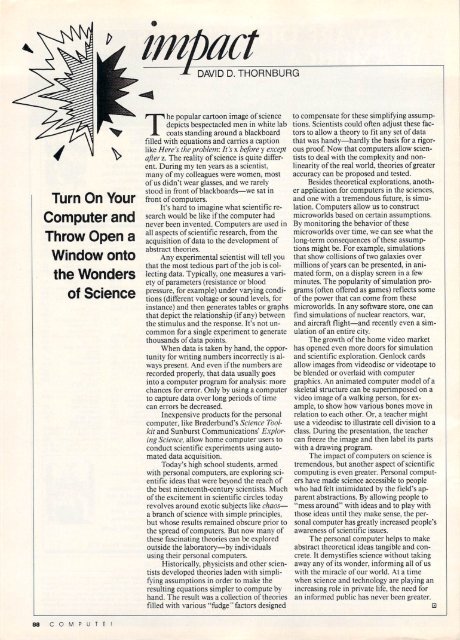& LIGHT-YEARS! - TRS-80 Color Computer Archive
& LIGHT-YEARS! - TRS-80 Color Computer Archive
& LIGHT-YEARS! - TRS-80 Color Computer Archive
You also want an ePaper? Increase the reach of your titles
YUMPU automatically turns print PDFs into web optimized ePapers that Google loves.
Turn On Your<br />
<strong>Computer</strong> and<br />
Throw Open a<br />
Window onto<br />
the Wonders<br />
of Science<br />
88 COMPUTE!<br />
impact<br />
JL nA\/m n thoi<br />
DAVID D.THORNBURG<br />
The popular cartoon image of science<br />
depicts bespectacled men in white lab<br />
coats standing around a blackboard<br />
filled with equations and carries a caption<br />
like Here's the problem: It's x before y except<br />
after z. The reality of science is quite differ<br />
ent. During my ten years as a scientist,<br />
many of my colleagues were women, most<br />
of us didn't wear glasses, and we rarely<br />
stood in front of blackboards—we sat in<br />
front of computers.<br />
It's hard to imagine what scientific re<br />
search would be like if the computer had<br />
never been invented. <strong>Computer</strong>s are used in<br />
all aspects of scientific research, from the<br />
acquisition of data to the development of<br />
abstract theories.<br />
Any experimental scientist will tell you<br />
that the most tedious part of the job is col<br />
lecting data. Typically, one measures a vari<br />
ety of parameters (resistance or blood<br />
pressure, for example) under varying condi<br />
tions (different voltage or sound levels, for<br />
instance) and then generates tables or graphs<br />
that depict the relationship (if any) between<br />
the stimulus and the response. It's not un<br />
common for a single experiment to generate<br />
thousands of data points.<br />
When data is taken by hand, the oppor<br />
tunity for writing numbers incorrectly is al<br />
ways present. And even if the numbers are<br />
recorded properly, that data usually goes<br />
into a computer program for analysis: more<br />
chances for error. Only by using a computer<br />
to capture data over long periods of time<br />
can errors be decreased.<br />
Inexpensive products for the personal<br />
computer, like Broderbund's Science Tool<br />
kit and Sunburst Communications' Explor<br />
ing Science, allow home computer users to<br />
conduct scientific experiments using auto<br />
mated data acquisition.<br />
Today's high school students, armed<br />
with personal computers, are exploring sci<br />
entific ideas that were beyond the reach of<br />
the best nineteenth-century scientists. Much<br />
of the excitement in scientific circles today<br />
revolves around exotic subjects like chaos—<br />
a branch of science with simple principles,<br />
but whose results remained obscure prior to<br />
the spread of computers. But now many of<br />
these fascinating theories can be explored<br />
outside the laboratory—by individuals<br />
using their personal computers.<br />
Historically, physicists and other scien<br />
tists developed theories laden with simpli<br />
fying assumptions in order to make the<br />
resulting equations simpler to compute by<br />
hand. The result was a collection of theories<br />
filled with various "fudge" factors designed<br />
to compensate for these simplifying assump<br />
tions. Scientists could often adjust these fac<br />
tors to allow a theory to fit any set of data<br />
that was handy—hardly the basis for a rigor<br />
ous proof. Now that computers allow scien<br />
tists to deal with the complexity and nonlinearity<br />
of the real world, theories of greater<br />
accuracy can be proposed and tested.<br />
Besides theoretical explorations, anoth<br />
er application for computers in the sciences,<br />
and one with a tremendous future, is simu<br />
lation. <strong>Computer</strong>s allow us to construct<br />
microworlds based on certain assumptions.<br />
By monitoring the behavior of these<br />
microworlds over time, we can see what the<br />
long-term consequences of these assump<br />
tions might be. For example, simulations<br />
that show collisions of two galaxies over<br />
millions of years can be presented, in ani<br />
mated form, on a display screen in a few<br />
minutes. The popularity of simulation pro<br />
grams (often offered as games) reflects some<br />
of the power that can come from these<br />
microworlds. In any software store, one can<br />
find simulations of nuclear reactors, war,<br />
and aircraft flight—and recently even a sim<br />
ulation of an entire city.<br />
The growth of the home video market<br />
has opened even more doors for simulation<br />
and scientific exploration. Genlock cards<br />
allow images from videodisc or videotape to<br />
be blended or overlaid with computer<br />
graphics. An animated computer model of a<br />
skeletal structure can be superimposed on a<br />
video image of a walking person, for ex<br />
ample, to show how various bones move in<br />
relation to each other. Or. a teacher might<br />
use a videodisc to illustrate cell division to a<br />
class. During the presentation, the teacher<br />
can freeze the image and then label its parts<br />
with a drawing program.<br />
The impact of computers on science is<br />
tremendous, but another aspect of scientific<br />
computing is even greater. Personal comput<br />
ers have made science accessible to people<br />
who had felt intimidated by the field's ap<br />
parent abstractions. By allowing people to<br />
"mess around" with ideas and to play with<br />
those ideas until they make sense, the per<br />
sonal computer has greatly increased people's<br />
awareness of scientific issues.<br />
The personal computer helps to make<br />
abstract theoretical ideas tangible and con<br />
crete. It demystifies science without taking<br />
away any of its wonder, informing all of us<br />
with the miracle of our world. At a time<br />
when science and technology are playing an<br />
increasing role in private life, the need for<br />
an informed public has never been greater.

















